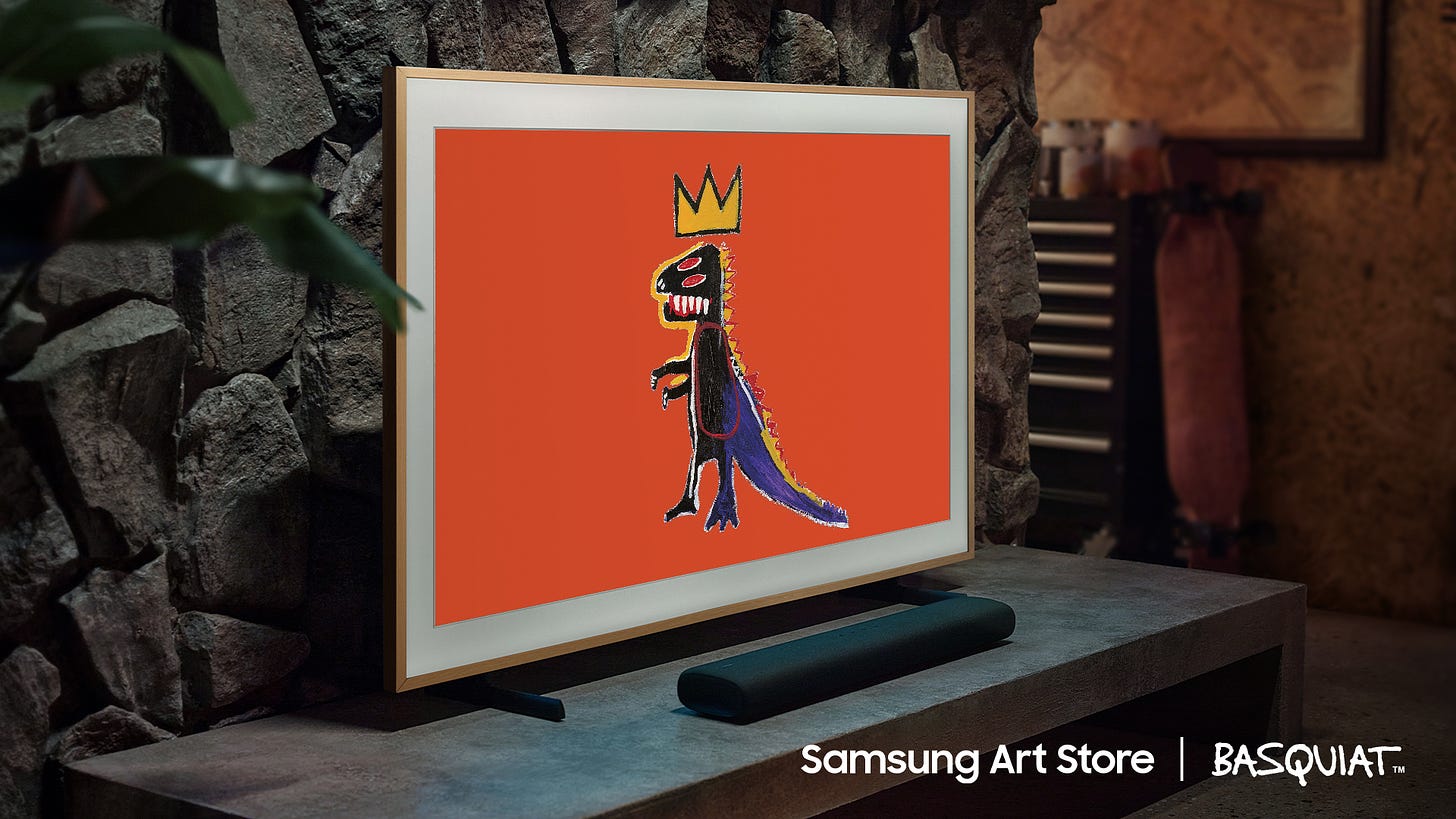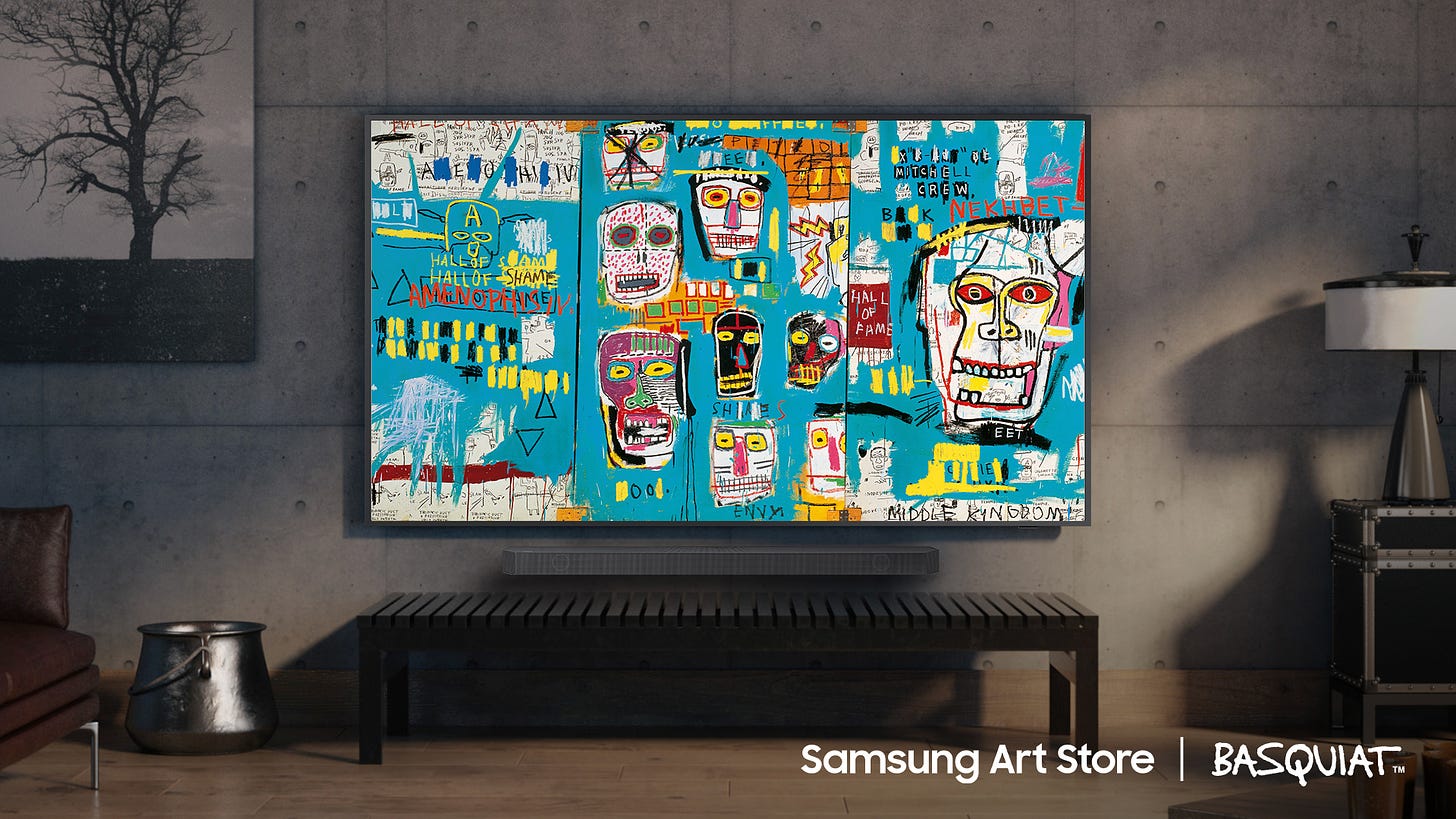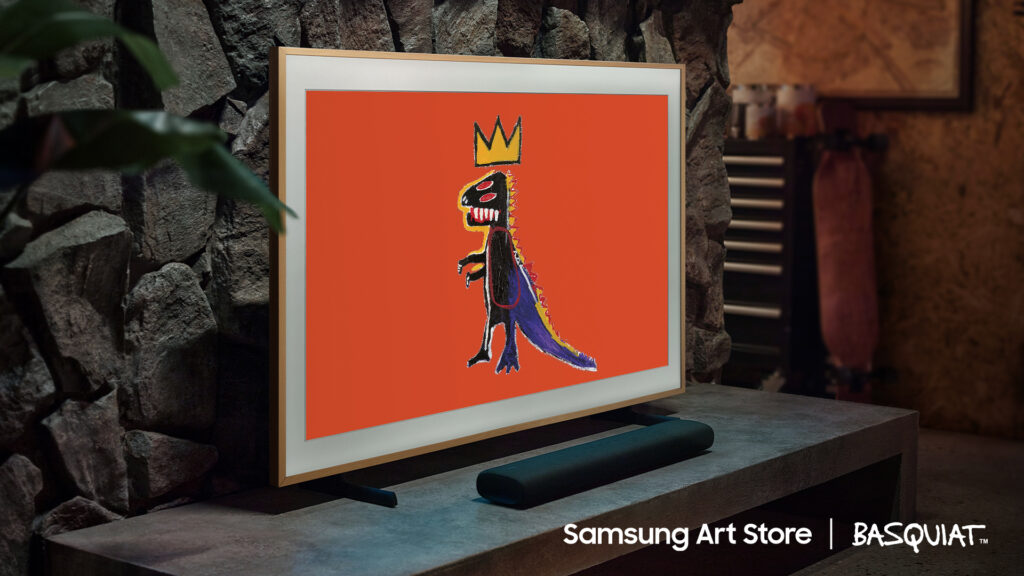
Jean Michel Basquiat died in 1988, only 27 years old. At the time of his death, Basquiat’s talent and importance were acknowledged but no one could have predicted how much his work would matter today, almost 40 years later. Or that his work would be available everywhere: in museums, galleries, independent art attractions, on stickers, T-shirts, tote bags, even on your TV.
At this week’s New York Contemporary art auctions, works by Basquiat broke new records. At Phillips’ auction, an eight-foot-wide painting from 1982, Untitled (ELMAR) sold for $40.2 Million. At Christies, another 1982 work, The Italian Version of Popeye has no Pork in his Diet, sold for $30 Million.
In recent years, The Brant Collection, the art foundation of Peter Brant, has exhibited their extensive collection of Basquiats in New York. LA’s The Broad Museum has exhibited their 13 Basquiats (they offer Basquiat Skateboard decks in the gift shop).
King Pleasure, the Basquiat family’s traveling exhibition of his life and work, features more than 200 of his works, as well as recreations of his home dining room and one of his studios, and has a full-on gift store with stylish and well executed merchandise including denim jackets, bucket hats, tote bags, mugs, temporary tattoos, air pod and iPhone cases, and kitchen magnets.
Basquiat’s work, his aesthetic of child-like drawings and word clusters that remind us of a high schooler’s notebook, is immediately recognizable, unique, and speaks to our current obsessions with identity, untold histories, wealth, and fame.
Luna Luna, the recently revived artist-decorated amusement park that has recently decamped from Los Angeles, features a Basquiat-decorated ferris wheel – a miniature of which you can buy in their gift shop for $75.

You can now even have works by Basquiat on your TV! This month Samsung announced a deal with the Basquiat estate for 12 works, the first ever appearing in a digital format for their super-thin TV called the Frame which comes with a bevel that looks like a picture frame, as well as its Art Store a subscription service of artworks. The Art store subscription is $49.90 a year or $4.99 a month. with over 2,500 pieces of digital art, including exclusives made by artists Barry X. Ball, Shepard Fairey, and now 12 works by Basquiat, the first time Basquiat works have been presented in a digital format.
Among the works available to Art Store subscribers are Bird on Money (1982), Basquiat’s tribute to one his idols, Jazz musician Charlie Parker as well as King Zulu (1986), which is a later work that is less cluttered, and has large color blocks; and a 1982 dual portrait with Andy Warhol, Dos Cabezas.
You might think that such commercialization would cheapen the brand or make Basquiat’s art less appreciated. It hasn’t.
Should you find yourself in Beverly Hills, Gagosian has a great show, Jean-Michel Basquiat: Los Angeles, of paintings and series made during Basquiat’s several residencies in the city. It’s an excellent show, exceptional paintings and prints, certainly one of the best Basquiat exhibitions I’ve seen.
Some of the works have been described being like a window into Basquiat’s brain – and that is apt, as they are filled with esoteric research and fan-like appreciations, as well as Basquiat’s own disquisitions on racism, Black History, American culture, capitalism, as well as the ownership and commercialization of American popular culture. Knowing that Basquiat died of an overdose, it is also hard not to attribute some of his more disordered, seemingly incomplete work as having been made under the influence.
Basquiat’s work appeals to many people on many different levels. It is worth noting that Basquiat began his artistic career as a Graffiti artist with the moniker SAMO whose work, even then, was distinguished by its poetic yet often inscrutable word phrases and combinations. Other artists of that same era, not just Keith Haring, but also Barbara Kruger, Jenny Holzer, and Ed Ruscha also have made text a prime driver in their work.
Basquiat’s enduring appeal is in part, historical, due to his unicorn status as seemingly the only well-known Black artist of his time, surrounded by white peers (of course there are many other Black artists in the US and around the world who were working then, and many still working today, but Basquiat stood out in the popular reporting of the time).
Beyond that, Basquiat jumbled his personal iconography, his rough, and scratch-like painting, his overloaded references, in a manner that begs, and at the same time, resists interpretation. This sense of a mystery to be solved is a compelling factor in the popular appreciation of Basquiat’s art. In this regard, I might compare Basquiat’s work to the songs of Bob Dylan, whose words are important to many but whose actual meaning is unexplained and elusive.
It is estimated that during his too short life, Basquiat made 1000 paintings and 1000 drawings. As is true of any artist, not every one of his works is a masterpiece. Yet there are works which originally seemed less coherent that are now recognized as great. And the number of great works Basquiat produced in so short a time is truly remarkable.
Thirty-six years after his death, we are now experiencing peak Basquiat.

